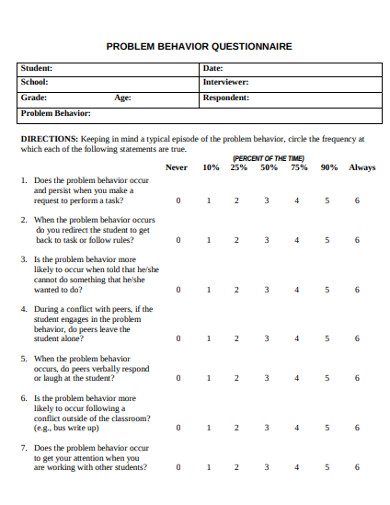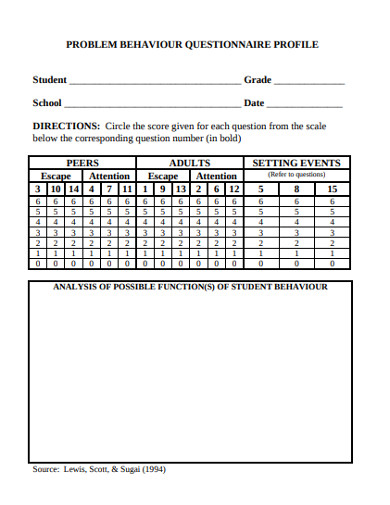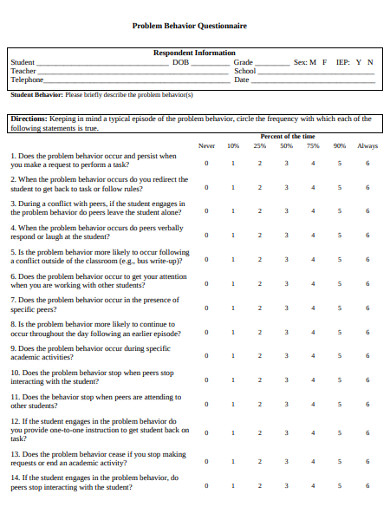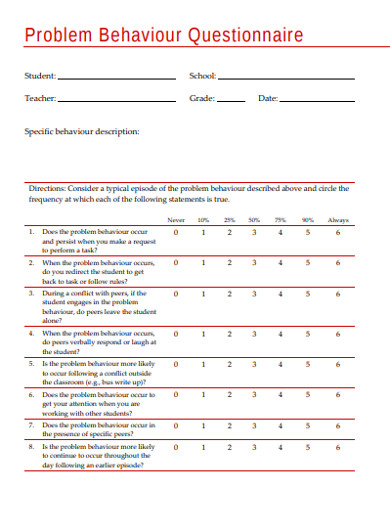Problem Behavior Questionnaire Examples
Children go to school and come out as capable adults. Being the environment that houses a majority of the child’s growth and development, the school is bound to encounter kids with problematic behavior. It is both the parent and the school’s responsibility to correct these behaviors early on with proper behavior management measures. In this regard, it is worthy of remembering that the problem is the behavior, not the child. Spot the onset and correct these behaviors early with problem behavior questionnaires.
What Is a Problem Behavior Questionnaire?
Problem behavior questionnaire is a teacher-centered survey tool that helps measure the frequency and gravity of the child’s problematic behavior. It removes vagueness of how the child’s behavior is reviewed and assessed. Moreover, the questionnaire helps the school evaluate the severity of the problem and address it appropriately. An infrequent misdemeanor might be due to external factors that triggered the child to be upset. However, frequent grievances can be a sign of a problem that may need professional help. You might also find a way to address the problem from the information in the questionnaires. For example, the child only acts out when he or she is with adults. Maybe the child lacks attention from his or her parents. Making him or her feel her parents’ love might change his or her behavior.
When the problematic behavior is addressed as soon as it appears, there is more chance that general and simple interventions will curb it. Since children in their early years are very impressionable, you will have more luck remediating the misbehavior than when they are already adults.
The School and Its Role in a Child’s Holistic Development
The school is a place for fun and learning. It is the venue of most of a person’s formative years. Here, children learn essential life skills. They learn how to do basic math and communicate effectively. They learn how to interact with their peers and people of different ages appropriately. They receive the knowledge and skills they need to make it on their own. The social nature of the school helps the child adjust well into society after graduation. We can imagine a school as a modified version of the reality outside its colorful gates. For this reason, the environment inside should also mirror how the outside works. This includes the laws, rules, and social conventions outside. For example, hurting someone is punishable in the real world. Therefore, schools should not condone a child’s display of aggressive and violent tendencies.
Because teachers are the closest thing to adults that the children interact with other than their family and relatives, it is of the teachers’ duty to parent the kids. Aside from providing the youth with adequate education, the teachers are responsible as well in teaching them the right manners and conduct. The children should be well-informed about why right is right and why the deviation from what is right is wrong. Furthermore, the children should understand why they are called out for something they have done.
In enforcing good behavior in class, the teachers and the school administration should be consistent. Consistency reduces the chances of one child feeling wronged because he or she got a worse punishment than his or her peer for the same act. Apart from that, the consequence of the misbehavior should be enforced after the misdemeanor happened. If you wait for several days to impose the sanction, it will be less clear for the child why he or she received a punishment. Enforce a consistent disciplinary action policy with set guidelines for what consists a bad behavior.
4+ Problem Behavior Questionnaire Examples & Templates
Questionnaires are effective prevention measures supplements because they help you spot the problem early on. Browse through the following sample problem behavior questionnaires to find the downloadable template that you need.
1. Sample Problem Behavior Questionnaire Example
2. Basic Problem Behavior Questionnaire Example
3. Problem Behavior Questionnaire profile Example
4. Problem Behavior Respondent Information Questionnaire
5. Formal Problem Behavior Questionnaire Example
How to Address a Problematic Behavior
Problem behavior questionnaires help teachers effectively manage classrooms. How do you curb a problematic behavior using the questionnaires above?
1. Define What is Problematic Behavior
First, you have to know what constitutes a problematic behavior. Remember that in early childhood, the child doesn’t have a definition of empathy yet. He or she is still self-absorbed, and everything is about him or herself. Therefore, the kid can exhibit bad behavior once in a while. The behavior only becomes problematic when it is already frequent, and it hinders his or her mental, social, and emotional development. And unless the misbehavior is addressed, the child will have difficulty in that and other areas of personal development. It is important to indicate in the questionnaire the signs of problematic behavior so that you can effectively monitor them.
2. Measure the Gravity of the Offense
Maybe the child is just throwing tantrums after not getting what he or she wants. It is a problem, but not a grave one. Any young child can exhibit this behavior. Nevertheless, you can still address this problem with general interventions. But when the child already seriously harms his or her peers or poses a danger to the people around him or her, it’s already a red flag and should be dealt with as soon as possible. Some problems may be more challenging than others. In your questionnaires, you should be able to indicate the frequency and gravity of a child’s offense. You can provide the necessary intervention with the information indicated.
3. Get to the Root of the Problem
Often, the answers to our questions are presented to us in plain sight. By tracking the child’s behavior with questionnaires, you can notice a pattern of problematic behavior. It could be that the child just wants love and attention from his or her family, and he or she doesn’t know how to express that. You can also notice if there is a problem in the child’s household because it will manifest in the child’s behavior. The information in your questionnaires may explain the problematic behaviors, and you just had to look closer. By responding to the root of the problem, you can eliminate the problematic behavior.
4. Provide Right and Timely Intervention
The consequence of the misbehavior should be appropriate with the child’s offense. Instead of hurting the child, like how people used to discipline in the past, make him or her understand why an act is wrong. Don’t tolerate the misbehavior, but don’t punish a child with belts and sticks. Instead, go for a more constructive approach. If the information in the questionnaires suggests that the child needs professional intervention, act on the issue as soon as possible. Inform the parents about your observation and behavior modification plan, and let them consider if they will allow their child to seek professional help. Don’t make decisions without consulting the parents because they are the legal guardian for the child. Since the kid is not yet legally capable of making his or her own decisions, the parents or closest guardian will make it for him or her.
Schools are the children’s metaphorical second home, and the teachers their second parents. The institution, the staff, and the parents are all responsible for raising the child into a responsible adult that can decide for him or herself the difference between right and wrong. By equipping students with both skills and virtue, we are in charge of remodeling society with promising potential.







